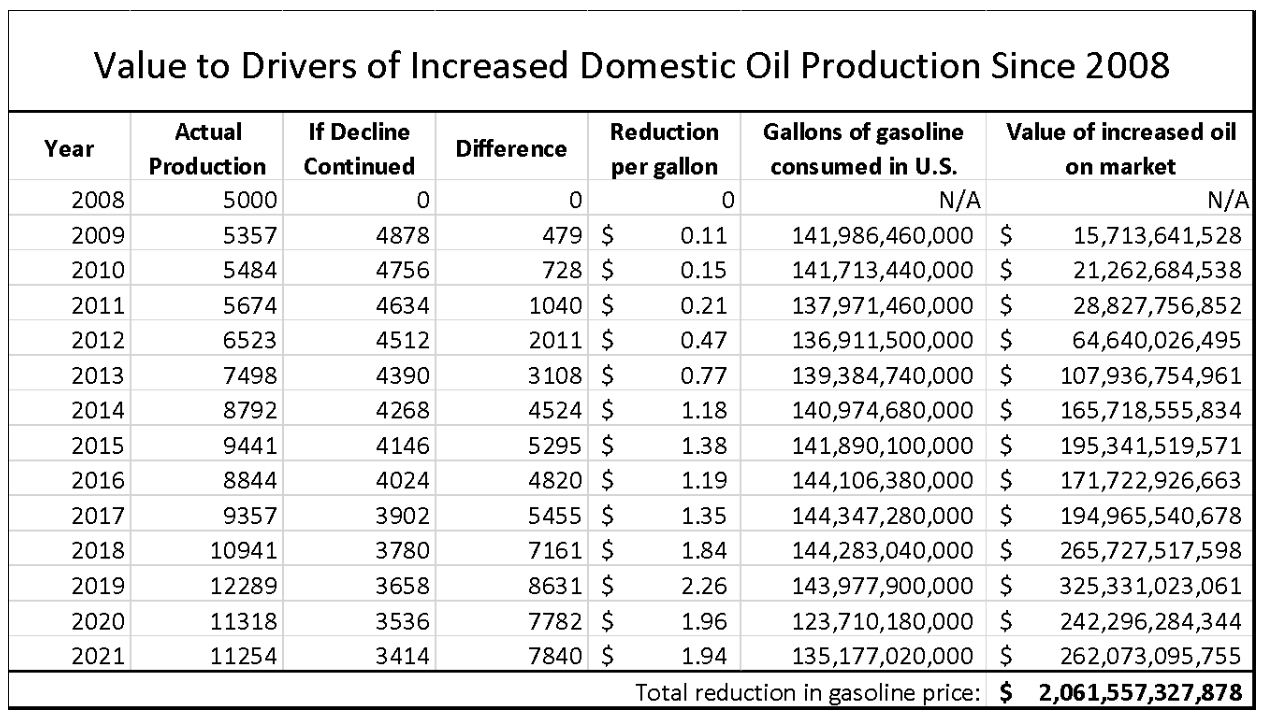The White House recently boasted that draining the Strategic Petroleum Reserve (and SPRs from other countries) saved Americans about 40 cents a gallon at the pump. The White House argued:
A new analysis from the Department of the Treasury estimates that these releases, along with coordinated releases from international partners, have reduced gasoline prices by up to about 40 cents per gallon compared to what they would have been absent these drawdowns.
This is significant for two reasons. First, it’s an admission from the White House that increasing the domestic supply of oil decreases the cost at the pump. More oil, lower prices. It’s not rocket science. Second, it gives us a White House-approved framework to estimate the value in lower gasoline prices of the increase in domestic oil production with the horizontal drilling/hydraulic fracturing revolution over the last decade; the one the Biden Administration has been opposing since his first day in office.
Just a few years ago, many “experts” thought that domestic oil production had peaked and we needed to use alternatives like biofuels. U.S. Oil production had peaked in 1970 and had slowly declined annually by an average of 112,000 barrels per day until in 2008, when domestic oil production bottomed out at 5.0 million barrels of oil production a day.
Thankfully, American innovators came along with advances including fracturing, horizontal and directional drilling, and subsurface imaging. This changed the course of U.S. oil (and natural gas) production and these advances changed the energy landscape. U.S. oil production more than doubled between 2008 and 2019 and the United States became the world’s largest oil producer and largest natural gas producer. According to BP Statistical Review of World Energy, from 2011 to 2019, global oil production increased by 10.9 million barrels of oil a day. The United States alone increased oil production by 9.2 million barrels of oil a day. Or put another way—85 percent of the global increase on oil production from 2011 to 2019 came from the United States.
How much did this increase in domestic production lead to lower prices at the pump? Last week the White House argued that the SPR release has resulted in lower gasoline prices, citing a quick study from the Department of the Treasury. The Treasury estimates that 1 million barrels a day of increased oil on the market leads to gasoline prices that are 13 cents to 31 cents lower a gallon (and the White House used the 31 cents in their estimate of 40 cents savings from the SPR release).
The following chart shows that, using the White House’s math, Americans have saved over $2 trillion at the pump since 2008 because of increased domestic oil production. That means the average family of four has saved over $24,000 because of increased production, just since 2008. The only question is why the Biden Administration…knowing this…has gone to war with our own domestic energy producers, even though they’re willing to use more oil stored away for emergencies.
- The first column shows the year.
- The second column shows the actual production in thousands of barrels a day.
- The third column shows what domestic production would have been if the average decline in domestic oil production since 1970 would have continued.
- The fourth column shows the difference new production made between the actual production and the likely decline if the decline had continued.
- The fifth column shows the reduction per gallon as a result of the increased production. The study the Biden administration used argued that an additional million gallons of production resulted in lower costs at the pump of up to 31 cents per gallon.
- The sixth column shows the total gallons of gasoline consumed in the U.S. per year.
- The seventh column shows the reduction per gallon multiplied by the number of gallons consumed.
It’s great to see the White House recognize that increased oil production leads to lower prices. Their math, shows that increased domestic oil production has saved $2 trillion since 2008 and currently about $2 a gallon at the pump.
The only question remaining is why, then, is the Biden Administration doing everything in its power to stop more oil and gas production in the U.S.A.?
